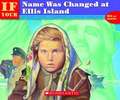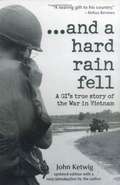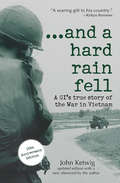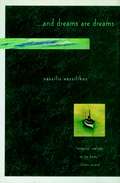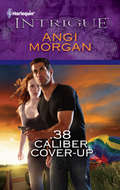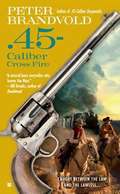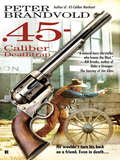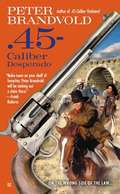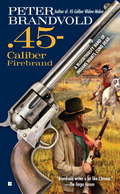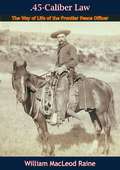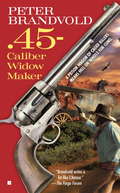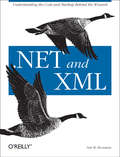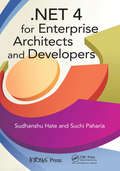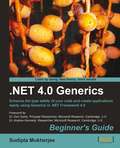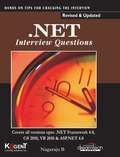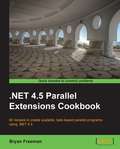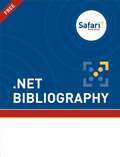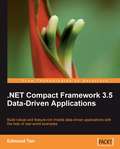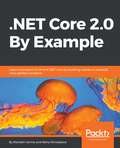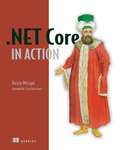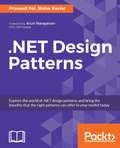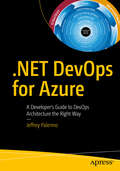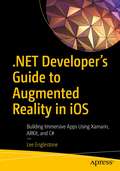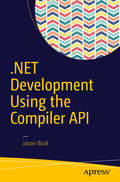- Table View
- List View
...If Your Name Was Changed at Ellis Island
by Ellen LevineA great way to celebrate the centennial of the great immigration movement through Ellis Island, this unique, interactive history book encourages readers to step into the past with its question-and-answer format. It's also packed with quotes from children and adults who passed through Ellis Island.
...and Economic Justice for All: Welfare Reform for the 21st Century
by Michael L. MurrayThe author presents an argument for a system of social insurance that replaces welfare with a Guaranteed Adequate Income. The book reviews public assistance programmes, and evaluates other plans that have been proposed.
...and a Hard Rain Fell
by John KetwigAn honest and soul searching true story of a GI's experience of the war in Vietnam
...and a hard rain fell
by John Ketwig"A magnetic, bloody, moving, and worm's-eye view of soldiering in Vietnam, an account that is from the first page to last a wound that can never heal. A searing gift to his country."-Kirkus ReviewsThe classic Vietnam war memoir, ...and a hard rain fell is the unforgettable story of a veteran's rage and the unflinching portrait of a young soldier's odyssey from the roads of upstate New York to the jungles of Vietnam. Updated for its 20th anniversary with a new afterword on the Iraq War and its parallels to Vietnam, John Ketwig's message is as relevant today as it was twenty years ago."Solidly effective. He describes with ingenuous energy and authentic language that time and place."-Library Journal"Perhaps as evocative of that awful time in Vietnam as the great fictions...a wild surreal account, at its best as powerful as Celine's darkling writing of World War One."-Washington Post
...and dreams are dreams
by Vassilis VassilikosGreece's most acclaimed living novelist gives us a magical realist portrait of contemporary Europe and contemporary Europeans. Here are seven tales that explore the themes of materialism, post Cold War politics, love, religious faith, and the power of imagination. In the tradition of Gabriel García Márquez and Luigi Pirandello, Vassilikos writes of the fantasies within reality, the spirit in existence, and the art within life.
.38 Caliber Cover-Up
by Angi MorganUndercover DEA agent Erren Rhodes was used to working alone. So the very idea of teaming up with Officer Darby O'Malley to ferret out a killer wasn't exactly how he thought this critical mission would go. But thanks to information only the beautiful cop possessed, finding whoever was responsible for shooting Erren's friend made Darby a valuable- and irresistible- partner. Digging into the case, though, revealed a far-reaching conspiracy... and angered all the wrong people. Now, trying to bring a killer to justice while keeping Darby safe was making Erren remember why he was better off on his own. Especially when Darby made him long to hole up with her in the safe house and never let her out of his sight.
.45-Caliber Cross Fire
by Peter BrandvoldFugitive Cuno Massey is recruited to hunt down a gang of gunrunners who stole a wagon of weapons, intending to sell them to a Mexican general waging war against Yaqui Indians. To even the odds, Cuno forms an alliance with a Yaqui queen as savage as she is beautiful. With so much firepower and so many deadly players on the warpath, Cuno knows he's sitting atop a powder keg with a sizzling fuse...
.45-Caliber Deathtrap
by Peter BrandvoldAfter Cuno Massey's business partner is murdered by a gang of outlaws, he takes to the trail to find the killers. But Cuno's mission of vengeance becomes a rescue mission when he learns that the outlaws have kidnapped a young Chinese woman.
.45-Caliber Desperado
by Peter BrandvoldCuno Massey killed a pack of Deputy U.S. Marshals, but only because they were about to rape the women he was escorting to safety. Thrown into a federal penitentiary, he faces a death sentence-until the beautiful Camilla and her cutthroat gang bust him out and head for the Mexican border.
.45-Caliber Firebrand
by Peter BrandvoldCuno Massey finds himself stuck in the middle of a feud between a weary old rancher and a band of Indians hungry for revenge. With warring braves surrounding the ranch and a doomed man begging for help, Cuno?s the only rider left who stands a chance to save the rancher?s daughter for a savage massacre.
.45-Caliber Law: The Way of Life of the Frontier Peace Officer
by William MacLeod RaineWilliam MacLeod Raine was a small boy when he came to this country in 1881 from London, England, with his father and brothers. They settled in the Southwest, then a land lawless at times and places. Jesse James and Billy the Kid still terrorized the districts in which they lived. Most of the characters mentioned in this book were alive, and vigorously fighting for or against the law, while Raine was growing up.After his graduation from Oberlin College, in Ohio, young Raine returned to the West and lived there, although with frequent excursions to other parts of the world. He had been a newspaper reporter, an editorial writer, a university lecturer, and a contributor to magazines.For more than sixty years Raine was in and of the West. He knew personally some of the men whose adventures he tells of in this book, and from other of their friends and acquaintances he picked up details and anecdotes. Even in his fiction Raine was noted for the accuracy with which he portrays the spirit and the background of the locale in which his characters move.
.45-Caliber Widow Maker
by Peter BrandvoldCuno Massey is determined to start a new, peaceful life. But when he comes across a prison wagon under attack, he can't just ride on. A gang of outlaws is hell-bent on granting four hardened convicts an early release, and with the only lawman down, the marshal is badly outnumbered. Dispensing frontier justice from the barrel of his Colt .45, Cuno does his best to even the odds and keep the murderous animals where they belong.
.NET & XML: Understanding the Code and Markup Behind the Wizards
by Niel M. BornsteinIf you're seeking ways to build network-based applications or XML-based web services, Microsoft provides most of the tools you'll need. XML is integrated into the .NET Framework and Visual Studio .NET, but if you want to get a grasp on how .NET and XML actually work together, that's a different story. With .NET & XML, you can get under the hood to see how the .NET Framework implements XML, giving you the skills to write understandable XML-based code that interoperates with code written with other tools, and even other languages..NET & XML starts by introducing XML and the .NET Framework, and then teaches you how to read and write XML before moving on to complex methods for manipulating, navigating, transforming, and constraining it. To demonstrate the power of XML in .NET, author Niel Bornstein builds a simple hardware store inventory system throughout the book. As you move from chapter to chapter, you'll absorb increasingly complex information until you have enough knowledge to successfully program your own XML-based applications. This tutorial also contains a quick reference to the API, plus appendices present additional .NET assemblies that you can use to work with XML, and how to work with the .NET XML configuration file format.One study puts the potential market for new software based on XML at or near $100 billion over the next five years. The .NET Framework gives you a way to become a part of it. But to use XML and .NET effectively, you need to understand how these two technologies work together. This book gives you the insight to take full advantage of the power the two provide.
.NET 4 for Enterprise Architects and Developers
by Sudhanshu Hate Suchi PahariaPresenting cutting-edge insights from industry practitioners, .NET 4 for Enterprise Architects and Developers supplies in-depth coverage of the various server-side features of Microsoft .NET Framework 4 that can be leveraged in Enterprise Application development. It provides a fundamental understanding of the technical aspects of implementation and
.NET 4.0 Generics Beginner’s Guide
by Sudipta MukherjeeThis is a concise, practical guide that will help you learn Generics in .NET, with lots of real world and fun-to-build examples and clear explanations. It is packed with screenshots to aid your understanding of the process. This book is aimed at beginners in Generics. It assumes some working knowledge of C# , but it isn't mandatory. The following would get the most use out of the book: Newbie C# developers struggling with Generics. Experienced C++ and Java Programmers who are migrating to C# and looking for an alternative to other generic frameworks like STL and JCF would find this book handy. Managers who want to know what Generics is and how to put it to good use. Architects will find the benchmarking extremely useful, because it's the first of its kind across a framework of several collections.
.NET 4.0 Interview Questions
by Nagaraju B.Highly recommended for beginners, students, and professionals, this book covers the unknown or hidden areas of NET implementation, starting from the basic to the advanced level-from NET Framework to OOPS to remoting to web services, i.e. VBNET, C#NET, and ASP NET; from ADO NET to XML, XSL, and XSLT; from Remoting, which forms the basis for advanced BizTalk, to SharePoint; from smart devices to Web Services and NET Framework 3.0 that discusses WPF, WF, WCF, and WCS foundations, and much more. Contents:- Framework ? Programming Concepts ? OOPS ? Windows Forms Controls ? ADO NET ? eXtensible Markup Language (XML) ? Remoting ? ASP NET NET Compact Framework ? Web Services NET Framework 3.0
.NET 4.5 Parallel Extensions Cookbook
by Bryan FreemanThis book contains practical recipes on everything you will need to create task-based parallel programs using C#, .NET 4.5, and Visual Studio. The book is packed with illustrated code examples to create scalable programs.This book is intended to help experienced C# developers write applications that leverage the power of modern multicore processors. It provides the necessary knowledge for an experienced C# developer to work with .NET parallelism APIs. Previous experience of writing multithreaded applications is not necessary.
.NET Bibliography
by Safari Content TeamWhen Microsoft released the first beta of the .NET Framework in 2000 it quickly became the default way of developing software for Windows. Rising from the technological legacy of COM, with the C# language, Common Language Runtime (CLR), Intermediate Language (IL) and Just-in-time (JIT) compilation, it was a modern platform that made it easy for Java and C++ developers to develop for Windows. At the same time, Visual Basic .NET provided a natural transition path for Visual Basic developers. Since then, .NET has evolved and branched through 7 major releases of the framework to the current day, and with Windows 8, Microsoft has surprised developers with a completely new UI stack. In this highly competitive world of technology, Microsoft makes the operating system that is running on over a billion computers, yet they continue innovating with unique features of programming languages, and breakthroughs such as Kinect or PixelSense. .NET offers an environment that is a pleasure to develop on and a consistent platform where you will feel at home moving from one technology stack to another. Should you decide to explore the exciting world of .NET development, be sure to use this bibliography to access Safari Books Online resources that will help you understand and master .NET programming.
.NET Compact Framework 3.5 Data Driven Applications
by Edmund TanThe book walks you through three different real-world mobile applications from head to toe to provide a practical, hands-on experience on how to use .NET CF. It provides you with code snippets (in both VB.NET and C#) from real-world business scenarios. A summary at the end of each chapter explains how these code snippets work together as a part of the larger whole. It also makes use of diagrams to explain core concepts and helps you decide on which design patterns to use in different enterprise application scenarios. This book is written for developers who are acquainted with the basics of .NET Compact Framework and want to create enterprise-level mobile applications. It is for developers who have worked with the .NET CF Framework before but would like to learn how to utilize its advanced features and deploy leaner and faster business applications.
.NET Core 2.0 By Example: Learn to program in C# and .NET Core by building a series of practical, cross-platform projects
by Rishabh Verma Neha ShrivastavaBuild cross-platform solutions with .NET Core 2.0 through real-life scenariosKey Features Bridges the gap between learning and doing and improves your software development skills Covers the best practices of .NET development to improve your productivity Example-based approach to get you started quickly with software programmingBook DescriptionWith the rise in the number of tools and technologies available today, developers and architects are always exploring ways to create better and smarter solutions. Before, the differences between target platforms was a major roadblock, but that's not the case now. .NET Core 2.0 By Example will take you on an exciting journey to building better software.This book provides fresh and relevant content to .NET Core 2.0 in a succinct format that’s enjoyable to read. It also delivers concepts, along with the implications, design decisions, and potential pitfalls you might face when targeting Linux and Windows systems, in a logical and simple way.With the .NET framework at its center, the book comprises of five varied projects: a multiplayer Tic-tac-toe game; a real-time chat application, Let'sChat; a chatbot; a microservice-based buying-selling application; and a movie booking application. You will start each chapter with a high-level overview of the content, followed by the above example applications described in detail. By the end of each chapter, you will not only be proficient with the concepts, but you’ll also have created a tangible component in the application.By the end of the book, you will have built five solid projects using all the tools and support provided by the .NET Core 2.0 framework.What you will learn Build cross-platform applications with ASP.NET Core 2.0 and its tools Integrate, host, and deploy web apps with the cloud (Microsoft Azure) Leverage the ncurses native library to extend console capabilities in .NET Core on Linux and interop with native coden .NET Core on Linux and learn how to interop with existing native code Reuse existing .NET Framework and Mono assemblies from .NET Core 2.0 applications Develop real-time web applications using ASP.NET Core Learn the differences between SOA and microservices and get started with microservice development using ASP.NET Core 2.0 Walk through functional programming with F# and .NET Core from scratchWho this book is forIf you are a developer or architect and want to learn how to build cross-platform solutions using Microsoft .NET Core, this book is for you. It is assumed that you have some knowledge of the .NET Framework, OOP, and C# (or a similar programming language).
.NET Core in Action
by Dustin MetzgarSummary .NET Core in Action shows .NET developers how to build professional software applications with .NET Core. Learn how to convert existing .NET code to work on multiple platforms or how to start new projects with knowledge of the tools and capabilities of .NET Core. Purchase of the print book includes a free eBook in PDF, Kindle, and ePub formats from Manning Publications. About the Technology .NET Core is an open source framework that lets you write and run .NET applications on Linux and Mac, without giving up on Windows. Built for everything from lightweight web apps to industrial-strength distributed systems, it's perfect for deploying .NET servers to any cloud platform, including AWS and GCP. About the Book .NET Core in Action introduces you to cross-platform development with .NET Core. This hands-on guide concentrates on new Core features as you walk through familiar tasks like testing, logging, data access, and networking. As you go, you'll explore modern architectures like microservices and cloud data storage, along with practical matters like performance profi ling, localization, and signing assemblies. What's Inside Choosing the right tools Testing, profiling, and debugging Interacting with web services Converting existing projects to .NET Core Creating and using NuGet packages About the Reader All examples are in C#. About the Author Dustin Metzgar is a seasoned developer and architect involved in numerous .NET Core projects. Dustin works for Microsoft. Table of Contents Why .NET Core? Building your first .NET Core applications How to build with .NET Core Unit testing with xUnit Working with relational databases Simplify data access with object-relational mappers Creating a microservice Debugging Performance and profiling Building world-ready applications Multiple frameworks and runtimes Preparing for release appendix A - Frameworks and runtimes appendix B - xUnit command-line options appendix C - What's in the .NET Standard Library? appendix D - NuGet cache locations
.NET Design Patterns
by Praseed Pai Shine XavierA practical and fast-paced guide that explores .NET design patternsAbout This BookThis book is based on the latest version of .NET, .NET Core 1.0.The code is explained piece by piece and the application of the pattern is also showcased.This fast-paced guide shows you how to implement the patterns into your existing applicationsWho This Book Is ForThis book is for those with familiarity with .NET development who would like to take their skills to the next level and be in the driver's seat when it comes to modern development techniques. Basic object-oriented C# programming experience and an elementary familiarity with the .NET framework library is required.What You Will LearnPut patterns and pattern catalogs into the right perspectiveApply patterns for software development under C#/.NETGOF and other patterns in real-life development scenariosHandle concurrency and parallelism using idioms under .NETLeverage Object/Functional programming by mixing OOP and FPUnderstand the Reactive Programming model using Rx and RxJsGet real-life insightsIn DetailKnowing about design patterns enables developers to improve their code base, promoting core reuse and making their architecture more robust.This book focuses on the practical aspects of coding in .NET. You will learn about all of the major design patterns, which will improve their functionality. We start with classic object-oriented programming (OOP) techniques, enhance implementations by mixing OOP and Functional Programming, and finally to the Reactive Programming model where Functional Programming and OOP are used in synergy to write better code.We'll focus on how to apply GOF patterns to solve real-life problems and improve the functionality of the software without changing the UI.Towards the end of this book, we'll show you how to deal with Architecture/Design techniques, GOF patterns, some patterns from other Catalogs, Functional Programming, and Reactive Programming techniques.After reading this book, you will be able to implement important design patterns for your programs, create major patterns viz. factory pattern, builder pattern, prototype patterns, adapter pattern, facade pattern, decorator pattern, etc.
.NET DevOps for Azure: A Developer's Guide to DevOps Architecture the Right Way
by Jeffrey PalermoUse this book as your one-stop shop for architecting a world-class DevOps environment with Microsoft technologies..NET DevOps for Azure is a synthesis of practices, tools, and process that, together, can equip a software organization to move fast and deliver the highest quality software. The book begins by discussing the most common challenges faced by developers in DevOps today and offers options and proven solutions on how to implement DevOps for your team.Daily, millions of developers use .NET to build and operate mission-critical software systems for organizations around the world. While the marketplace has scores of information about the technology, it is completely up to you to put together all the blocks in the right way for your environment.This book provides you with a model to build on. The relevant principles are covered first along with how to implement that part of the environment. And while variances in tools, language, or requirements will change the needed implementation, the DevOps model is the architecture for the working environment for your team. You can modify parts of the model to customize it to your enterprise, but the architecture will enable all of your teams and applications to accelerate in performance.What You Will LearnGet your .NET applications into a DevOps environment in AzureAnalyze and address the part of your DevOps process that causes delays or bottlenecksTrack code using Azure Repos and conduct acceptance testsApply the rules for segmenting applications into Git repositoriesUnderstand the different types of builds and when to use eachKnow how to think about code validation in your DevOps environmentProvision and configure environments; deploy release candidates across the environments in AzureMonitor and support software that has been deployed to a production environmentWho This Book Is For.NET Developers who are using or want to use DevOps in Azure but don’t know where to begin
.NET Developer's Guide to Augmented Reality in iOS: Building Immersive Apps Using Xamarin, ARKit, and C#
by Lee EnglestoneAttention .NET developers, here is your starting point for learning how to create and publish augmented reality (AR) apps for iOS devices. This book introduces and explores iOS augmented reality mobile app development specifically for .NET developers. The continued adoption and popularity of Xamarin, a tool that allows cross-platform mobile application development, opens up many app publishing opportunities to .NET developers that were never before possible, including AR development. You will use Xamarin to target Apple’s augmented reality framework, ARKit, to develop augmented reality apps in the language you prefer—C#. Begin your journey with a foundational introduction to augmented reality, ARKit, Xamarin, and .NET. You will learn how this remarkable collaboration of technologies can produce fantastic experiences, many of them never before tried by .NET developers. From there you will dive into the fundamentals and then explore various topics and AR features. Throughout your learning, proof of concepts will be demonstrated to reinforce learning. After reading this book you will have the fundamentals you need, as well as an understanding of the overarching concepts that combine them. You will come away with an understanding of the wide range of augmented reality features available for developers, including the newest features included in the latest versions of ARKit. What You Will Learn Create rich commercial and personal augmented reality mobile appsExplore the latest capabilities of ARKitExtend and customize chapter examples for building your own amazing appsGraduate from traditional 2D UI app interfaces to immersive 3D AR interfacesWho This Book Is For Developers who want to learn how to use .NET and C# to create augmented reality apps for iOS devices. It is recommended that developers have some Xamarin experience and are aware of the cross-platform options available to .NET. A paid Apple developer account is not needed to experiment with the AR code samples on your devices.
.NET Development Using the Compiler API
by Jason BockThis is the first book to describe the recent significant changes to the .NET compilation process and demonstrate how .NET developers can use the new Compiler API to create compelling applications. As an open source compiler, the Compiler API now makes its code available for anyone to use. In this book, you’ll get a concise, focused view of this tremendous resource for developers, who can now use any part of the platform implementation to their advantage in analyzing applications, improving code generation, and providing enforceable patterns, all under an OSS model.You will learn how to analyze your code for defects in a fast, clean manner never available before. You’ll work with solutions and projects to provide automatic refactoring, and you’ll discover how you can generate code dynamically to provide application implementations at runtimeHaving the Compiler API available opens a number of doors for .NET developers that were either simply not there before, or difficult to achieve. However, the API is vast, and this concise book provides a valuable roadmap to this new development environment.What You Will Learn:Understand how to generate, compile, and execute code for a number of scenariosHow to create diagnostics and refactoring to help developers enforce conventions and design idiomsExperiment with the compiler code base and see what can be done to influence the inner workings of the compilation pipelineWho This Book Is For:Experienced .NET developers, but detailed compiler knowledge is not necessary.
